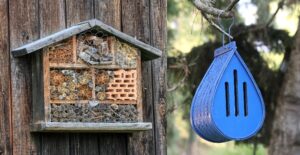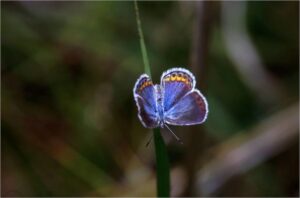If you spend any time reading about native landscapes, you will quickly find numerous articles and guides for plants that are good for pollinators. Many native pollinator species are in decline, and choosing plants that support their lifecycle is a great way homeowners and landscapers can engage with the effort to improve their populations. However, the plants that pollinators eat are only part of the story. Many species also need nesting and overwintering habitats that are disappearing at an alarming rate. You may have seen products aimed at filling this gap, such as butterfly nesting boxes or bee hotels, at your local garden outlet. Many people who desire to make their landscapes more suitable to native pollinators may purchase one of these products with good intentions. However, do these products actually have any benefit? What actions can you take to help native pollinators?
Nesting sites for native bees

Examples of a bee hotel (left) and a butterfly house (right). Images from pxfuel.com.
Most of our native bees are solitary species, meaning they do not live in social groups like honeybees. Some will nest in large groups and display social behaviors, but generally the females build individual nests and work alone. Ground-nesting species will dig tunnels in the soil, while cavity nesting species use holes in dead wood or hollow plant stems. Products such as “bee hotels” are designed to accommodate these cavity nesters. They will have holes or reeds of varying sizes for the females to nest in. As natural areas continue to decline, bee hotels are marketed as a way to replace these lost habitats.
Multiple studies have shown these products to have a questionable impact on native bee populations, and in some cases, they can actively cause harm. A study in Toronto, Canada on bee hotels found that introduced bee species and solitary wasps were more frequent nesters than native bees; in addition, native bees experienced higher rates of parasitism in bee hotels than introduced bees (Maclvor and Packer 2015). They concluded that the bee hotels helped solitary wasps and introduced bees more than they helped native bees. A similar study from Marseille, France also found bee hotels to have higher occupancy of introduced bees than native bees (Geslin et al. 2020).
Another frequent issue cited with bee hotels is sanitation. These products are not a “set and forget” option to help native pollinators. Bee hotels require sterilization and replacement of nesting tubes each year, or they can quickly become a breeding ground for fungus and parasites. In addition, unattended bee hotels will often become infested with spiders and other predators.
What can you do to make the best of your bee hotel? Are there better options to help native bees? Here are some suggestions to optimize native bee nesting habitat:
- Consider cutting back on the mulch and leaving some bare soil available for ground-nesting bees. Approximately 70% of our native bees are ground nesters – bee hotels don’t help them at all! They require direct access to soil to build their nests. Even a thin layer of wood chip mulch is enough to stop them. Alternatively, you could mulch with shredded leaves or compost.
- Plant pithy or hollow-stemmed plants (raspberry, elderberry, hydrangea, etc), and leave the dead branches available for native bees to build their nests.
- Leave that tree stump! While it may be an eyesore, it is a great habitat for solitary nesting insects.
- Introducing native mason bee or leafcutter bee cocoons to your bee hotel can jump-start the native bee occupancy. A reputable vendor will send appropriate native species for your region, and will advise you on the best season to release them. These species are extremely gentle, sting-averse bees that are a delight to watch. Additionally, they are incredible pollinators for your garden!
- It is absolutely critical to clean your bee hotels! Removable reeds/tubes or wood trays that open to allow access to cocoons are strongly recommended for ease of cleaning. Offer fresh nesting materials each year. Use a bee-friendly solution, such as a hypochlorous acid cleansing spray, to thoroughly sterilize the house.
- Regularly harvest reeds that are “full” throughout the season – that is, you can see the end of the reed is capped. Place these reeds in a fine mesh bag to protect them from parasitoids, and store them in a sheltered area such as a shed or garage. They can remain there for the entire year. In late winter, carefully crack them open and harvest the healthy pupae. You can release these pupae the following year. Placing pupae in a box with a small hole will protect them from birds, and they can emerge on their own time when the season is right. For more detailed, step-by-step instructions on pupae harvesting and storage, check your seller’s website for education materials.
- Monitor your setup for ants, wasps, spiders, and birds. Part of the issue with bee hotels is that they artificially congregate bees that would typically live in isolation, and so predators who find the bee hotel can easily wipe out all the bees. Use a bird guard to protect the nesting materials, or coat the mounting post with Fluon® to stop spiders and ants from crawling inside.
Butterflies in decline
You may have seen headlines about the decline in monarch populations, or the critically endangered Karner blue butterfly, and are looking for ways to help. Another common product is the butterfly house, which supposedly provides a hibernation space that is protected from weather and predators.

Endangered Karner blue butterfly. Image credit: US Fish and Wildlife Service.
Unfortunately, there is no evidence that these products benefit butterflies. The primary reason for this is that butterflies very rarely, if ever, use them (Alton and Ratnieks 2020). You are far more likely to provide shelter to cockroaches, spiders, and wasps than butterflies. In fact, a recent study from Kentucky found that invasive paper wasps, which are significant predators of monarch caterpillars in urban environments, frequently build nests in these hibernation boxes (Baker and Potter 2020). The study also found that paper wasp predation of monarch caterpillars was much higher in urban pollinator gardens than in natural rural habitat. This means the box you put up for the butterflies in your urban garden might be worsening the paper wasp population rather than protecting butterflies.
So then, what can concerned citizens do to help our native butterflies? This depends on the species, of course, so let’s focus on the two butterflies mentioned previously that have a lot of public interest.
For monarchs, the general advice to plant native milkweed species still applies, although recent work suggests that the spatial pattern of milkweeds is important to maximize egg laying. Pitman et al. (2018) found that monarch egg density was highest in small (< 16 m2) and low-density (0–2 milkweed stems per m2) milkweed patches compared to larger, high-density patches. Similarly, Baker and Potter (2019) showed that configuration of milkweeds in an urban garden significantly affected egg laying. They compared three designs: milkweeds placed around the perimeter, milkweeds placed in the interior, and a random mix of milkweeds and other plants. Monarchs strongly preferred to lay eggs on milkweeds that were planted evenly around the perimeter of a garden, with the nectar plants in the center. The next time you are planting milkweeds, consider the above studies when designing their layout. Low density plantings with milkweeds spaced apart could improve egg laying and increase the benefit of your garden.
When it comes to Karner blue butterflies, it’s important to understand the ecological requirements of this species. Karner blues are dependent on wild lupine (Lupinus perennis) as their sole larval food source, which is a plant that requires oak savanna and oak pine barrens. The decline of Karner blues is linked to the destruction of these habitats. Conserving and restoring oak savannas is the most important action we can take to help these butterflies. While the effectiveness of planting wild lupine in urban landscapes is unknown, what we do know is that Karner blues only occur in large stands of wild lupine (Zaremba 1991). Therefore, small plantings are unlikely to have any impact.
The decline of our native pollinators is a complex, multi-faceted issue. There are several factors involved related to climate change, habitat destruction, pesticide use, invasive species, and more. As concerned citizens, the best thing we can do is promote conservation and restoration of our native habitats.
Citations:
Alton and Ratnieks, 2020. Caveat Emptor: Do products sold to help bees and pollinating insects actually work? Bee World, 97(2): 57-60. https://doi.org/10.1080/0005772X.2019.1702271
Baker and Potter, 2019. Configuration and location of small urban gardens affect colonization by monarch butterflies. Front. Ecol. Evol., 7. https://doi.org/10.3389/fevo.2019.00474
Baker and Potter, 2020. Invasive paper wasp turns urban pollinator gardens into ecological traps for monarch butterfly larvae. Sci Rep, 10. https://doi.org/10.1038/s41598-020-66621-6
Geslin et al., 2020. Bee hotels host a high abundance of exotic bees in an urban context. Acta Oecologica, 105. https://doi.org/10.1016/j.actao.2020.103556.
MacIvor and Packer, 2015. ‘Bee Hotels’ as tools for native pollinator conservation: a premature verdict? PLoS ONE 10(3): e0122126. https://doi.org/10.1371/journal.pone.0122126
Pitman et al., 2018. Patterns and causes of oviposition in monarch butterflies: Implications for milkweed restoration. Biological Conservation, 217: 54-65. https://doi.org/10.1016/j.biocon.2017.10.019.
Zaremba R.E., 1991. Management of Karner blue butterfly habitat in a suburban landscape. In Challenges in the Conservation of Biological Resources. 1st ed. Routledge. 289–302.